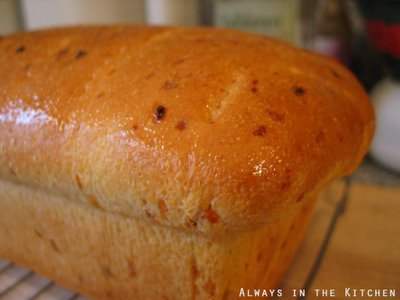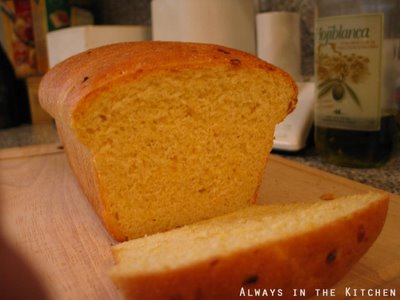 I have a lot to live up to, in the bread-making department.
I have a lot to live up to, in the bread-making department.When I first started making bread, it was my mother's brown bread that I made. Dense with whole wheat and added wheat germ and bran, dark with molasses, enriched with eggs and baked in six-loaf batches, her bread was a hearty, filling loaf that rounded out a bowl of soup or stew into a dinner quite handily. The recipe, for which - alas! - I do not have a written copy, was tricksy. She gave it over and over to friends and community members who admired her bread, but they almost universally reported failure of their attempts to replicate her bread.
For some reason, her recipe just didn't work well for others, but I was one of the few who could even come close - although mine never rose quite as high as hers and therefore was a little denser and a little crumblier. That was the bread that I grew up with as sandwich bread; a sandwich made from two of these slices would sit with you for a while.
We did occasionally have other, lighter breads in the house, when I was growing up, usually in the form of soft French loaves - batards - that were our favourite base for garlic bread on spaghetti dinner nights. I was enamoured of their airy texture, which was foreign and exotic seeming to me, but didn't have the sugary squidge of the white sandwich bread my schoolmates had in their lunches. In my late teens I discovered sourdough rye breads, and cheese breads. Despite my affection for "regular" bread, what a delightful discovery these new breads were! My eyes were opened to the possibilities.

When I began experimenting with bread baking in my twenties, I quickly came up with a heartier type of white bread of my own: The Cornmeal Cheddar Onion loaf. I played with the proportion of cornmeal to wheat flour, and experimented with using raw minced onion or sauteed. I adjusted the level of cheese, and since I was at the time shifting towards sharp or aged cheeses, that simple change afforded a whole new level of cheese flavours.
It's a tasty bread, but it does have limited applications. It makes excellent toast, for example, and a shockingly good toasted cheese sandwich, but sweet applications and peanut butter are pretty much out of the question. It was originally designed as a breakfast bread - something heartier than your average loaf, to stay with you in the morning, but it translates to other meals pretty well. The cornmeal does reduce the amount of glutinous spring in the bread, so untoasted sandwiches can be a touch crumbly, but with a little capicolla and fresh mozzarella...maybe a little basil...it can be a delicious lunch. At mid-day or in the evening, next to a steaming bowl of soup, it holds its own.
Cornmeal Cheddar Onion Bread
Makes 1 loaf
1 cup warm water
1 tablespoon active dry yeast
1 teaspoon sugar
1 egg, beaten
3 tablespoons olive oil
1/2 small onion, very finely minced
2 1/2 to 2 3/4 cups unbleached all-purpose flour
3/4 cup yellow cornmeal
1 cup grated sharp cheddar
pinch salt
In a large mixing bowl, sprinkle the yeast and sugar over the warm water. Let stand until it gets foamy-looking. While the yeast is getting foamy, sauté the onion in the olive oil. It will seem like a lot of olive oil, but go with it - that's how much the bread needs. When the onion is soft and translucent, remove from the heat and allow it to cool. Mix the flour, cornmeal, cheese, and salt together in a separate bowl.
Add the beaten egg to the foamy yeast mixture, and then stir in the somewhat-cooled onion and olive oil. Add a cup of the flour mixture to the wet mixture, and beat with a wooden spoon for about 100 strokes. This will help the overall texture of the bread. Add the rest of the flour mixture and stir slowly until it is all incorporated into a nice doughy ball. If your dough is still quite sticky and wet, dust it with flour.
Turn the dough out onto a lightly floured surface, and knead until it starts to feel like a cohesive bread dough. This can take up to ten minutes of kneading, and you may need to add a little flour here and there to keep it from sticking to your fingers. That's okay, but don't get carried away and add so much flour that the bread dough becomes stiff and unyielding.
Place the ball of dough in a lightly oil mixing bowl. Allow the bread to rise, covered, in a draft-free area for 45 minutes to 1 hour, or until nicely doubled. Press the air out of it ("punch it down") and shape it carefully into a loaf. Place in a greased loaf pan, and allow to rise in a draft-free area for about ½ hour. Place in a pre-heated oven at 375°F and let bake for 35-40 minutes, or until it sounds hollow when tapped on the bottom. Turn out of the pan to cool on a wire rack.
Note: If you like a nice, shiny brown top crust, you may wish to brush it with a little egg wash before putting it in the oven. Just beat up an egg with a little water, and use a pastry brush to apply a thin layer of the wash to the loaf just before it goes in the oven.
Dawna,
ReplyDeleteThis bread looks rich and delicious. Your serving suggestions make me want to have it for lunch today! Definitely will have to try it out.
Thanks, Dianka. It's not really all that rich, though, despite the cheese. Soaking it in butter though... heavenly.
ReplyDeleteThis bread looks beautiful Dawna. Where is the recipe?
ReplyDeleteHi Ana,
ReplyDeleteThe recipe for this is going up on my main site in the November 16 update (next week). I'll post a direct link to it when it goes up, but the main site is located here.
That looks so good. I think I'll try it soon.
ReplyDeleteDawna--I'm so impressed and inspired by your breadmaking tales! I'm going to try to some whole wheat dinner rolls next week.
ReplyDeleteThanks, Randi!
ReplyDeleteLisa, let me know how your rolls turn out. I love freshly made rolls with dinner. Or with breakfast, for that matter.